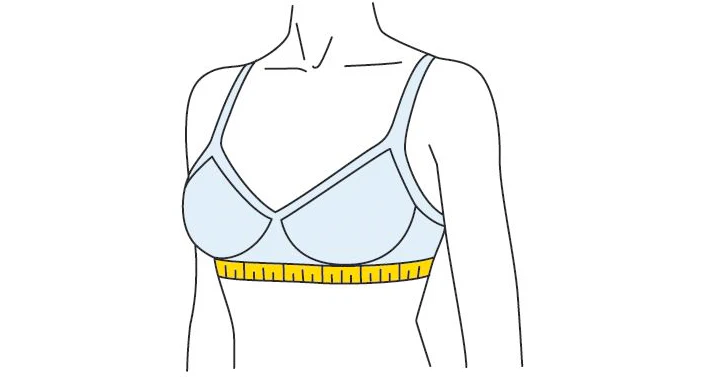Why Knowing How to Calculate Bra Size is Essential
Contents
Finding the right bra size is a crucial part of feeling comfortable and confident in your clothing. A poorly fitted bra can lead to discomfort, back pain, and a less-than-perfect silhouette. Many people struggle with calculating their correct bra size, but once you know how to calculate bra size, it’s easy to ensure that you’re wearing the best fit for your body type.
In this article, we’ll guide you through the process of calculating your bra size, explaining each step in detail, and sharing tips for achieving the most accurate results. Whether you’re new to measuring or just looking for a refresher, this guide will help you determine your perfect size.

What Is Bra Size?
Before we dive into the steps, it’s important to understand what a bra size is and how it’s structured.
Understanding the Components of a Bra Size
A bra size typically consists of two parts:
- Band Size (the number): This is the measurement around your ribcage, just beneath your bust. It represents the width of the bra band.
- Cup Size (the letter): This refers to the difference between your bust measurement and underbust measurement, which determines how much room the cup provides.
For example, a 34B bra means a 34-inch band with a B cup size.
How to Calculate Bra Size: Step-by-Step Instructions
Calculating your bra size may seem complicated at first, but with the right tools and measurements, it’s a simple process. Follow these steps to get an accurate bra size.
Step 1: Measure Your Underbust (Band Size)
To begin, you need to measure around your ribcage, directly under your bust. This will help you determine your band size.
- Get a soft measuring tape and wrap it around your ribcage, ensuring it’s snug but not tight.
- Keep the tape level around your body and take the measurement at the point where your ribcage is widest.
- Round the measurement to the nearest whole number. If it’s an even number, add 4 inches. If it’s an odd number, add 5 inches. This adjustment is made to account for the stretch of the bra band.
For example, if your underbust measures 30 inches, you would add 4 inches to get a band size of 34.
Step 2: Measure Your Bust (Bust Size)
Next, measure around the fullest part of your bust. This measurement will help you determine your cup size.
- Stand straight with your arms relaxed at your sides.
- Wrap the measuring tape around your chest at the fullest point of your bust. Be sure that the tape is level across your back.
- Take the measurement while keeping the tape comfortably snug but not tight.
Step 3: Calculate Your Cup Size
Now that you have both the band size and bust measurement, you can calculate your cup size by finding the difference between the two.
- Subtract your band measurement (underbust) from your bust measurement.
- The result corresponds to the following cup sizes:
- 1-inch difference = A cup
- 2-inch difference = B cup
- 3-inch difference = C cup
- 4-inch difference = D cup, and so on.
For example, if your bust measurement is 36 inches and your band size is 34 inches, the difference is 2 inches, which means you would wear a 34B.
Step 4: Double-Check Your Measurements
It’s always a good idea to recheck your measurements to ensure accuracy. If you’re unsure about any step, repeat it to make sure you’ve got the correct numbers.
What Are Common Mistakes When Calculating Bra Size?
Many people make common mistakes when calculating their bra size. Here are a few to watch out for:
- Not Measuring Under the Bust Correctly: The band size is based on the underbust measurement, so it’s crucial to measure this area accurately. Ensure that the tape is snug, level, and positioned correctly just beneath your breasts.
- Measuring Over Clothing: Always measure directly on your skin or over a very thin layer of clothing. Clothes can add bulk and give you inaccurate measurements.
- Rounding Incorrectly: When measuring the underbust, round up to the nearest even number to get an accurate band size.
- Not Accounting for Size Changes: Your body can change over time, and it’s essential to check your measurements regularly, especially after significant weight loss or gain, pregnancy, or hormonal changes.
How to Find the Right Bra for Your Calculated Size
Once you’ve calculated your correct bra size, it’s time to start shopping! However, knowing your bra size is just the first step. You also need to consider the following factors when choosing the perfect bra:
1. Band Fit
The band should fit snugly around your ribcage without digging into your skin. If the band is too loose, the straps will bear more weight, causing discomfort.
2. Cup Fit
Make sure the cups are snug but not tight. If the cups overflow or gap, your bra size may need adjustment. Always ensure your breasts are fully contained within the cups.
3. Bra Style
Different bra styles offer different levels of support and comfort. Here are a few options:
- T-shirt Bra: Smooth cups and seams for a seamless look.
- Sports Bra: Provides maximum support during physical activity.
- Push-Up Bra: Adds lift and cleavage.
- Balconette Bra: Gives a rounded, lifted shape with a lower cut.
4. Fabric and Materials
Choose materials that suit your lifestyle and comfort needs. Cotton bras are breathable and comfortable for daily wear, while lace or satin bras are perfect for special occasions.
How Often Should You Calculate Your Bra Size?How to calculate Bra size
Your bra size may change over time, so it’s important to recalculate it regularly. Here are some common reasons your size may change:
- Weight Gain or Loss: Significant weight changes can alter both your bust and underbust measurements.
- Pregnancy or Postpartum: Hormonal changes can affect the size of your bust, so recalculating your bra size is essential during pregnancy or after childbirth.
- Age and Hormonal Changes: As you age, your body changes, and this can impact your breast size and shape.
It’s recommended to measure your size every six months to ensure your bras always fit comfortably and provide proper support.
How to Calculate Bra Size with Confidence
Knowing how to calculate bra size is the first step toward finding a bra that fits perfectly and supports you in all the right ways. By following the steps outlined above, you can easily determine your band and cup size and feel confident in your fit.
Remember that your bra size can change over time, so it’s essential to check your measurements periodically. A properly fitted bra not only provides comfort but also promotes better posture and confidence.
FAQ: Common Questions About How to calculate Bra size
Q1: How do I know if my bra is the right size?
If your bra feels comfortable, doesn’t dig into your skin, and supports your breasts without spillage, it’s likely the correct size.
Q2: What happens if I wear the wrong bra size?
Wearing the wrong size can lead to discomfort, poor posture, and even back pain. It’s essential to wear a well-fitted bra for support and comfort.
Q3: Can my bra size change after pregnancy?
Yes, pregnancy and breastfeeding can affect your bust size. It’s a good idea to remeasure after childbirth.

